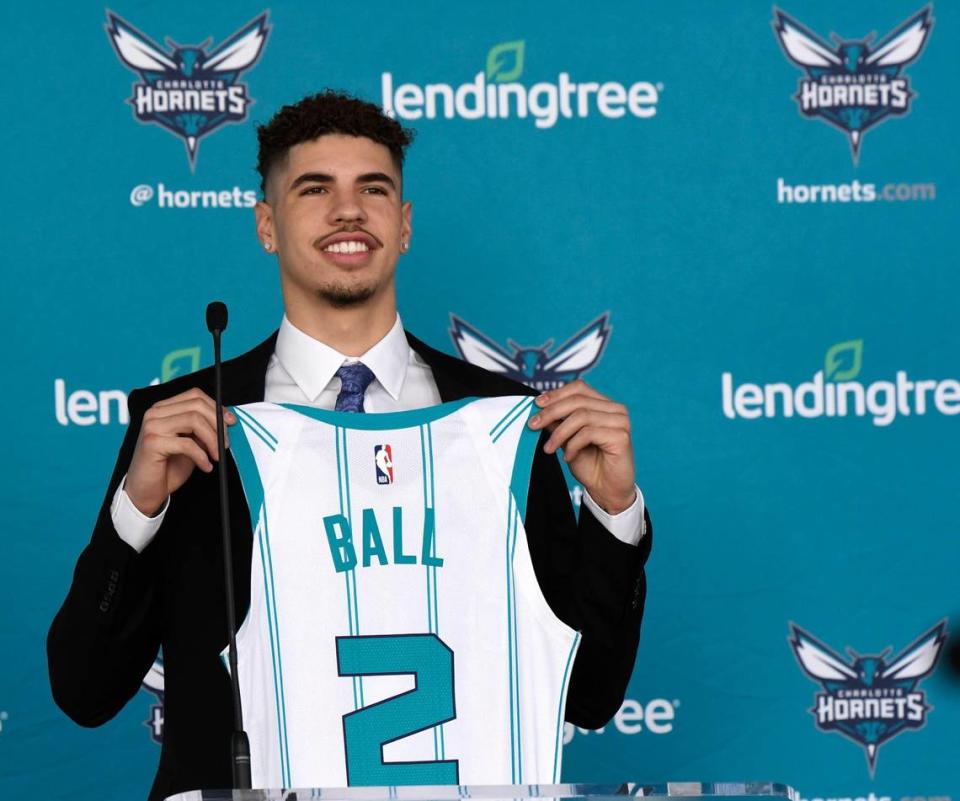How a spread-the-wealth offense by adding Hayward and Ball could get Hornets right
- Oops!Something went wrong.Please try again later.
Charlotte Hornets point guard Devonte Graham will have the ball a lot less this season.
He isn’t just OK with that, he’s excited how diversity can fix the Hornets’ offense.
“Not having all the attention on me is going to help everybody,” Graham said of adding playmakers Gordon Hayward and LaMelo Ball.
“It’s going to open up even more opportunities, even more shots — not just for myself, but other guys like Terry (Rozier), Miles (Bridges), P.J. (Washington). And when Gordon or LaMelo is off the ball, it will open up things for them.”
The Hornets ran an offense last season heavily focused on guards Graham and Rozier. In usage (a percentage of team plays used by an individual player on the floor), Graham ranked 66th in the NBA last season (24.3%) and Rozier was 91st (23.2%).
It was progress that Graham emerged as a primary scorer in his second NBA season, and that Rozier contributed so much in his first season in Charlotte. But too often the Hornets offense was predictable and inefficient. Charlotte finished last in field-goal percentage and 19th among 30 teams in 3-point percentage.
“The defense is not going to just focus on me coming off the pick-and-roll,” Graham said. “Now, you have to focus on LaMelo and Gordon. It’s going to make it easier on all of us. ... A lot less off-the-pick-and-roll forced shots.”
Winning playmakers
The Hornets identified two areas of major need this offseason: Rebounding and playmaking. They didn’t do much to fix the NBA’s worst defensive-rebounding percentage. But they dramatically improved their playmaking by drafting Ball and adding free agent Hayward.
“Big playmakers that can see over the defense, that can create for (themselves), create for others,” coach James Borrego described of 6-8 Ball and 6-7 Hayward. “If you look at rosters that are winning in today’s league, they have these type of guys.”
Ball’s natural position is point guard, but at his size, general manager Mitch Kupchak also pictures Ball as a part-time “point forward.” Hayward is a scorer (17.3 ppg. last season with the Boston Celtics), but he also averaged four assists. The Hornets see Hayward as a connector who improves decision-making and ball-movement.
That means Graham, who shot 37% last season from 3-point range, and Rozier (41% from 3), shouldn’t have to work so hard to find open looks.
Equal opportunity
Even before the Hornets successfully recruited free agent Hayward, Kupchak and Borrego talked of an offense that would empower more players this season to start the offense straight off the rebound.
Maybe not every player will have the go-ahead to grab-and-go, but Ball and Hayward change the approach, which Graham welcomes.
“Coach tried to stress that even last year: Whoever gets the ball, bring it (up court). But a lot of times it was me and Terry going back to get the ball. (Borrego) would stress to us, get up the court and run!”
Borrego needs to raise the Hornets’ pace and create some easy baskets. They were last in pace last season (99.8 possessions per game) and 21st among 30 in fast-break points (11.6 per game).
Ball loves throwing lob passes and is excited about Washington’s and Bridges’ ability to play above the rim. Hayward came to Charlotte in part because he would have a bigger playmaking role. The parts are there.
“I think I’m somebody who can do a little bit of everything,” Hayward said. “The thing I like to do the most is play-make and create for others.”


